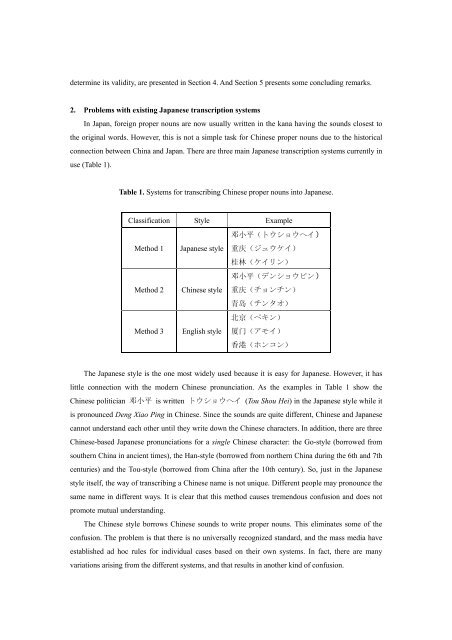j-pinyin: A New Systematic Approach to the Japanese Transcription ...
j-pinyin: A New Systematic Approach to the Japanese Transcription ...
j-pinyin: A New Systematic Approach to the Japanese Transcription ...
Create successful ePaper yourself
Turn your PDF publications into a flip-book with our unique Google optimized e-Paper software.
determine its validity, are presented in Section 4. And Section 5 presents some concluding remarks.2. Problems with existing <strong>Japanese</strong> transcription systemsIn Japan, foreign proper nouns are now usually written in <strong>the</strong> kana having <strong>the</strong> sounds closest <strong>to</strong><strong>the</strong> original words. However, this is not a simple task for Chinese proper nouns due <strong>to</strong> <strong>the</strong> his<strong>to</strong>ricalconnection between China and Japan. There are three main <strong>Japanese</strong> transcription systems currently inuse (Table 1).Table 1. Systems for transcribing Chinese proper nouns in<strong>to</strong> <strong>Japanese</strong>.Classification Style ExampleMethod 1Method 2Method 3<strong>Japanese</strong> styleChinese styleEnglish style邓 小 平 (トウショウヘイ)重 庆 (ジュウケイ)桂 林 (ケイリン)邓 小 平 (デンショウピン)重 庆 (チョンチン)青 岛 (チンタオ)北 京 (ペキン)厦 门 (アモイ)香 港 (ホンコン)The <strong>Japanese</strong> style is <strong>the</strong> one most widely used because it is easy for <strong>Japanese</strong>. However, it haslittle connection with <strong>the</strong> modern Chinese pronunciation. As <strong>the</strong> examples in Table 1 show <strong>the</strong>Chinese politician 邓 小 平 is written トウショウヘイ (Tou Shou Hei) in <strong>the</strong> <strong>Japanese</strong> style while itis pronounced Deng Xiao Ping in Chinese. Since <strong>the</strong> sounds are quite different, Chinese and <strong>Japanese</strong>cannot understand each o<strong>the</strong>r until <strong>the</strong>y write down <strong>the</strong> Chinese characters. In addition, <strong>the</strong>re are threeChinese-based <strong>Japanese</strong> pronunciations for a single Chinese character: <strong>the</strong> Go-style (borrowed fromsou<strong>the</strong>rn China in ancient times), <strong>the</strong> Han-style (borrowed from nor<strong>the</strong>rn China during <strong>the</strong> 6th and 7thcenturies) and <strong>the</strong> Tou-style (borrowed from China after <strong>the</strong> 10th century). So, just in <strong>the</strong> <strong>Japanese</strong>style itself, <strong>the</strong> way of transcribing a Chinese name is not unique. Different people may pronounce <strong>the</strong>same name in different ways. It is clear that this method causes tremendous confusion and does notpromote mutual understanding.The Chinese style borrows Chinese sounds <strong>to</strong> write proper nouns. This eliminates some of <strong>the</strong>confusion. The problem is that <strong>the</strong>re is no universally recognized standard, and <strong>the</strong> mass media haveestablished ad hoc rules for individual cases based on <strong>the</strong>ir own systems. In fact, <strong>the</strong>re are manyvariations arising from <strong>the</strong> different systems, and that results in ano<strong>the</strong>r kind of confusion.


